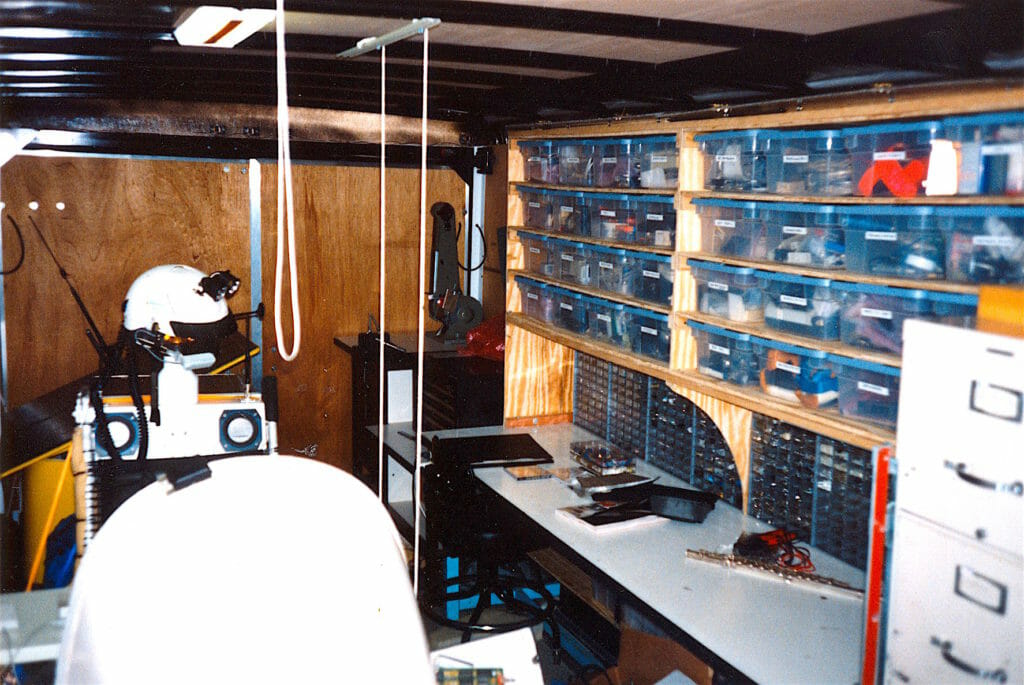
Bikelab Report #13 – Mothership and Mini-reviews
by Steven K. Roberts
Silicon Valley, California
October 30, 1991
“Pardon me, do you have any Grey Poupon?”
— unknown cyclist on RAGBRAI, passing me on a 90-degree day as I cruised easily with Cusco on the stereo and ice water circulating through my helmet.
Shakedown post-mortem
Well, I’m back at the lab. Three months of adventure have passed since I left the clutter that once again stares me in the face, and the perspective thus gained helps me see it as just that. The shakedown served its intended purposes: highlighting what’s important, revealing the unnecessary, smoking out poor components, and interjecting amusement into something that was becoming entirely too serious. It also led to a major change, but more on that in a moment.
This was a strange one, as tours go — it had a beginning and an end. In our last installment, I was languishing in Lansing trying to get it together enough to roll again after the epoch of Susan… pedaling southeast to Ann Arbor and thence into Ohio. I lounged about in Joe Tyner’s house for a couple of weeks, becoming part of the family, learning for the nth time the subtle, maddening truth in Moon’s observation that “the wanderer’s danger is to find comfort.” Days were spent studying Japanese and puttering; nights passed lazily with family dinner, good conversation, and the always-available cable TV in my basement hideaway.
One weekend my friend from Racine flew over the lake for an interlude of play, and we cruised the campus scene — stopping innocently in the bookstore to browse. My current educational obsession in the foreground, thinking more of the joys of learning than the horrors of packing, I innocently bought six Japanese language books and a couple of CDs to go with them.
Something changed at that moment, though I didn’t know it yet. Jitensha no naka ni Nihongo no hon ga rokusatsu arimasu ne…
You got it. A couple days later, I awoke in a glow of ambition, reassembled the Tyners’ hide-a-bed, checked the route to Ann Arbor on the map, and performed the familiar ritual of imposing granularity onto my vast pile of possessions by stuffing them into packs. I hauled everything out to the driveway, backed BEHEMOTH into the brittle Michigan sunshine, started a Cleo Laine CD, and began to load up — stuffing things into familiar corners, maximizing trailer packing density to the best of my ability and hoping as always that the huge pile on the ground would somehow fit.
But this time, it didn’t. I rearranged and tried again; tucking a few things in with the cooling system and even shoving some laundry into the pillow bag bungeed atop the manpack, but to no avail. Hm. It was the book that broke BEHEMOTH’s back, so to speak — that sextet of Japanese books pushed my load over the edge.
I sat down and stared at it, suddenly demotivated. Yeah, I suppose I could ship a few things ahead… or even get rid of some stuff if I tried hard enough. But it seemed like too much work. What I really wanted was to get back to the lab and finish the job — to weave together all the standalone systems that were not yet integrated into a network, write some code, and make the damn thing talk. Continuing from Lansing seemed pointless, anticlimactic. Susan was gone, it was getting cold, and I had six Japanese books that wouldn’t fit.
The choice was clear. I went out and bought a mother ship.
Jitensha –> Jidoosha
The books were the trigger, but there was a deeper cause. The fundamental flaw in this latest phase of my chronic nomadness is the need for a rather substantial base-lab — at the moment, 1200 square feet generously sponsored by Sun Microsystems. This won’t last forever, and I’ve been ignoring the impending crisis: what am I to do with all the support systems when this space is eventually converted into something more in line with traditional corporate activities? Cast about for another host company? Rent something, get domestic, and sink into debt? Impose heavily on a friend, taking over a spare room while wandering without easy access to backups and major tools?
It turns out that the support systems (or, put more conventionally, all my STUFF) can be parsed into four levels of relevance: stuff that lives on the bike, stuff that I need whenever I’m not pedaling, stuff that must remain available for backups or eventual integration into a conventional <shudder> lifestyle, and stuff I don’t need at all. The last category is easy: trash. So is the first: bike packs. The third category calls for a friendly storage space. And the second calls for a mother ship that’s always in the same general end of the world — or at least reachable. Given the sudden rash of invitations to exhibit BEHEMOTH at trade shows and speaking gigs, the idea of a mobile “base lab” suddenly makes a lot of sense. Not a sag wagon, but a relocatable shop and hiding place.
And so, to cut to the chase, I bought a new 20-foot Wells Cargo trailer and an ’87 GMC van to pull it. Having blown about $3,000 on rental trucks in the last year, a purchase was easy to rationalize… so I spent a few days on bike tie-downs and basic furniture like the desk in this photo, got everything registered and insured at my new Michigan address, and hit the road — breezing through Ann Arbor, Adrian, Marion, Columbus, Cincinnati, and Louisville before zooming across the vast and desolate midsection of the US, enroute once again to Silicon Valley.
I hasten to add that this gas-guzzling monster (about 1.7 light years per cubic mile of gasoline) is NOT an alternative to the bike: it’s a mobile lab. More than a semantic difference, this implies a fourth layer in the hierarchy of nomadic components:
- A detachable manpack with basic survival tools and laptop
- BEHEMOTH
- The Mother Ship, cabled into the bike when berthed
- A home base (one of these days)
All these will network together to take advantage of each others’ processing, power, and communication resources. At the moment, this translates into the existing bike/manpack systems, with a connector for the mother ship’s umbilicus when I’m running on dead dinosaurs. (To get specific, one of the first tasks is to mount a laptop on the van’s console, and provide a pair of audio channels to the bike’s crosspoint matrix. This will take care of cellular phone, ham radio, database access, and satellite datacomm (assuming, of course, that the antennas are remoted to the outside of the big metal box when the bike’s parked inside). I’ll also add some solar panels to the trailer’s roof to keep things alive when I’m out pedaling.)
Anyway, I picked up Maggie to return her to the west coast, turned the key, and 3,000 miles passed. (Would I ever say THAT after crossing the country by bicycle? There’s the essential difference…. no matter how bleak the country, interesting things always happen when you pedal. Not so when you sit staring out the window with your foot on the gas.) I’m back at the Sun lab until March, with two trade shows on opposite ends of the west coast between now and then to help me warm up to the new twist in this lifestyle. And before I go on to the long-awaited mini product reviews, I’d like to put out a feeler to this alias…
The BEHEMOTH Road Show coming your way?
I don’t think I ever mentioned that I’m not independently wealthy. (Freelance writers seldom are, though you’d be surprised at the assumptions some people make when they see the bike.) What this means is that I occasionally have to WORK — whether through the much-heralded process of publishing <chuckle>, an occasional consulting relationship, or speaking and trade-show gigs. Now that I have the mother ship, emphasis will be on the latter.
If your organization would like to have a close-up look at BEHEMOTH, let’s talk. I’m putting together a 1992 tour schedule around North America, beginning full time in March (although Bay Area appearances between now and then are possible). I can bring the bike to your company, campus, club meeting, or trade show — and make any of a variety of presentations suited to the crowd. Email me if you’d like to explore this further.
(Incidentally, I’ll try to be a good little technomad and publish advance notice of any known public showings, riding interludes, or media events here on the net — once they’re nailed down. It currently appears that I will be in San Diego in mid-January and Seattle at the end of February.)
Product Mini-Reviews
One of the main purposes of this recent shakedown cruise through Iowa, Illinois, Wisconsin, and Michigan was to subject the new equipment to road abuse and see how it survives. As usual, the results were mixed — some products are stellar performers and some are junk. Since part of my job is to pass along such insights, I offer a batch of entirely subjective mini-reviews, presented in the order I happened to think of them:
DeLORME ATLASES: A+
The best. These maps are so good that I don’t want to do any bicycle touring in states that DON’T have them. At present, DeLorme atlases exist for WA, OR, CA, MN, WI, IL, MI, OH, TN, VA, PA, NY, NH, VT, ME, and FL. Packaged like full-size US atlases, they break up each state into roughly 23 x 34 mile rectangles — densely packed with useful information. From a bicycle touring perspective, they show you all the roads that automobile drivers never use, and that alone makes them well worth their weight on even the lightest bike. There are also listings of parks, campgrounds, natural attractions, wineries, and much more. If you’re touring in any of those states, these are essential.
PHIL WOOD HUBS, old model: C — New model: A
I had some drama with what became known as “the disk brake from hell,” but as it was a custom creation, it doesn’t make sense to saddle it forever with a mini-review (it dragged due to braze-on misalignment, and unscrewed from the hub when trying to hold the bike stable on a hill. Let’s talk instead about the hub. On the eve of RAGBRAI, my Phil Wood hub failed — the flanges started slipping relative to the stainless hub body. In the past, I’ve had bearings start floating relative to the body as well (going down a mountain in the dark — very exciting), and the reason for all of this is that it was made from 5 independent parts glued together… with no true mechanical support. They were very nice parts, mind you; they just didn’t always stay together under heavy abuse. The temporary hack for the first day of RAGBRAI involved drilling four holes through flange and body and pinning it with short sections of DT 14-gauge spokes. This actually worked, but was on the verge of failing after 60 miles.
The company sent me a new model to replace the old, and it was built into a 48-spoke undished wheel by Gaylord Hill of Cyclopedia. This hub is much more solid, and the flanges are part of the all-aluminum model. They now have an even newer one that is easily field-serviceable, and is available in quick release. Very good stuff.
STEREO SYSTEM: A-
This is a multi-vendor subsystem, and as such isn’t really a product review. But I do want to report that the Blaupunkt HC-1030 honeycomb speakers, Yamaha YPA-100 18-watt-per-channel amp, and Sony D-T66 Discman CD player with tuner performed extremely well. Audio quality with the speakers built into the RUMP is astonishing, with crisp highs and startling bass support (most people look around for the OTHER speakers, which don’t exist). The Yamaha amp is exceptionally quiet, much more so than the other models I tested (including an absolutely AWFUL Blaupunkt unit with built-in graphic equalizer and a Sony unit that burned twice the standby power as this one).
The reason for the A- is the Sony. The clunky spindle accepts CDs reluctantly, and the tuner — for a $100 premium — is terrible, offering no scan mode, a clumsy user interface, and mediocre reception. Next time out, I’ll run a cable from the excellent Sony ICF- SW1 shortwave with FM stereo, switching that into the amp when I need a break from the finite CD library.
Shock mounting was adequate for the average reasonably smooth road, but could be better (this is not the vendor’s fault, though there is a wide range in the market when it comes to CD shock isolation — shop carefully). The older Sony D-180K appears to be better in that department, but I went through two of them with serious electronic problems (noisy power supply and clock drift) before switching to this model. What’s going on here? I though Sony products were always perfect?
ICOM 725 HF TRANSCEIVER; OUTBACKER ANTENNAS: A
This first class portable HF ham rig put up with heavy abuse under all sorts of shock and vibration conditions, and still let me chat with a guy in Verona, Italy while wandering around Michigan. Easy to use, easy to program, no problems. I’ve just added the AM/FM and narrow-CW modules, and they work great — in the latter case, much better than the ringing and touchy external filter. The pair of 7-band Outbacker whips configured as a dipole worked flawlessly atop an extendable fiberglass mast, pivoting on a custom assembly made by Steve desJardins. The whole getup looks seriously bizarre when deployed, but I’m used to that.
AUTEK QF-1A and WM-1: C
These ham-radio products, an external active audio filter and a computing SWR bridge and wattmeter, represent a pretty good cost/performance ratio. I repackaged them and got them working somewhere in Wisconsin, and am generally satisfied.
But the filter, like most analog approaches to the problem, is touchy to operate and introduces ringing and other distortion. And the meter, under some operating conditions, gives negative readings of power and SWR! The review unit at QST does the same thing occasionally, relieving fears that I have some kind of strange transmission-line problem on the bike.
Nevertheless, the units work well for the price, and have withstood the physical abuse better than some of the competitors in the same price range.
J-COM MAGIC NOTCH FILTER: A+
Pure magic. This bit of wizardry sits between your ham transceiver and the speaker, constantly scanning (when enabled) for any kind of continuous tone (like some bozo tuning up on frequency, or, as is common on the bike, a computer-generated birdie). When it finds one, it drops a 30 Hz notch on top of it and it’s gone. That’s all there is to it — no knobs to twiddle. If you have a birdie or heterodyne problem, get one.
LANDING GEAR: A-
This saved me; it’s that simple. Created by Steve desJardins, these pneumatically actuated landing gear are deployed for parking, or whenever I’m in the ultra-granny gear and pedaling slowly up a steep hill. I quickly reached the point where I could extend and retract them on the fly (via a spring-loaded toggle under the seat), and stopping halfway up a hill to rest without even putting my feet down is now a routine matter. Without them, starting again would be almost impossible.
The wheels are 6″ pneumatics built for wheelchairs by Quickie Designs. The main bearing is a modified CQP crank spindle. Air handling components were provided by Frank Fox of SMC Pneumatics in San Jose, and Steve did the rest — including a trailing arm shock-cord suspension reminiscent of the old Piper Cub, and a 4-bar mechanism coupled to a double acting cylinder actuated by solenoid-operated valves. The air supply is the tank originally installed for the air horns, and I’ve just acquired a tiny 12-volt piston pump that can recharge it every day or two so I don’t have to keep finding gas stations or wearing out my right arm.
The downside of the design is that it is not immediately adaptive to road surface variations, and thus bad steep roads can be quite dangerous. I’ve found myself using all kinds of body english trying to compensate for road crown, and a surprise bump can almost dump me. Next model should have two independent hydraulic struts that attempt to keep the bike vertical by dynamically adjusting their downward pressure as a function of force feedback and inclinometer data…
This is one of those things that looks like wretched excess but actually spells the difference between clumsiness and elegance. The cynical view is that I have just enough hardware to compensate for the weight of all this hardware, but I prefer to think of it as art.
OrCAD: A
The entire electronic design of the bike is managed within a hierarchical file structure of OrCAD sheets. A full discussion of CAD software is beyond the scope of these mini-reviews, but I’m continually amazed at the smooth integration and efficiency of this package. The company has just released the new ESP design environment (release IV), and even if you never plan to do printed circuit boards or PLD’s, it’s worth it just for the schematic capture. OrCAD makes your brain work better.
CYCLE BINDING SHOE/PEDAL SYSTEM: A-
I wish these people hadn’t gone out of business. Breaking into the bicycling market is extremely difficult — it’s style-driven and dominated by a few major vendors. Some excellent products appear and then quietly die, while some true junk gathers dust on the shelves for years.
Cycle Binding is in the first category. This shoe system is based on a successful ski binding design, and is particularly attractive for recumbent riders because the foot can float about 15 degrees around the set angle. On a normal bicycle, this isn’t necessary — a skinny seat is rammed up your, er, centerline to keep you aligned precisely with the bike. But a recumbent seat is wide and comfortable, meaning that you can incur a few degrees of error in the foot-pedal relationship… potentially causing knee problems with traditional cleats.
The shoes velcro on, and locking/unlocking to the pedal is so easy and smooth that I’ve never fallen over in the process (my major fear when first trying them). Since the cleat is female, walking is comfortable. And a subtle security benefit results from the difficulty of riding the bike without the proper shoes.
I hear the new Shimanos are excellent, and when these eventually wear out I’ll look into them. But for now, Cycle Binding, though no longer available, still gets my vote.
POQET PC: B
This little palmtop computer is an amazing machine — full DOS system in a tiny package. It has an acceptable keyboard, which places it well above the Atari Portfolio and others as a writing tool.
The big problem is the built-in editor, which is worthless. It word-wraps, of course… but if you want to go up a few lines and add some words it does not compensate — nor have I found any way to force a reformat (someone please tell me if there is one). The general software environment is fine and the other tools are OK… and slow speed is certainly no problem when the payoff is 40 or so hours of life on a couple of AA batteries. The screen is even 24×80.
My only other complaint is the little RAM card covers on the back, which only stay on if there’s a RAM or application card installed. Sticking duct tape on a exquisite packaging job like the Poquet rubs me the wrong way.
SOLAR SHOWER: A
Absolutely essential for cycle camping. They work, and make romantic evenings around the fire considerably more pleasant.
MAKITA POWER TOOLS: A+
Here’s another winner. After years of buying and then discarding consumer-grade Black & Decker and Craftsman electric drills (always suffering with them for a few years after the beginning of bearing or chuck failure until, in a fit of pique, I would be driven to buy another clunker), I broke down and got a good one. The 9.6-volt series of familiar blue-green tools from Makita are magnificent machines, and the bike carries both a reversible, 2-speed, 3/8″ drill and the flashlight — as well as a charger designed for 12-volt power systems. The flashlight, with spot and flood modes as well as a red rhodopsin-saving filter, is the most robust I’ve ever used (though it doesn’t replace the infinitely convenient Mini-Maglite in my pack). If you buy these tools, make sure you have 2 or more batteries so you don’t have to twiddle your thumbs for an hour halfway through a hole.
NOTE from 25 years later: I still love Makita, and have this LXT-series set on my boat.
THERMA-REST MATTRESSES: B+
This is the best camping mattress on the market.
One tip — in an emergency, you can make a “couple kit” with three strips of 3M adhesive-backed velcro (loop) on each mattress and corresponding strips of “hook.” Just let the stuff stick for about 24 hours before getting too rambunctious. And if you don’t have the official patch kit, barge cement works (though it’s not very pretty).
Contact your camp supply store.
EUREKA! EQUINOX 6 TENT: A+
This is amazing. When I was tent shopping for this new system, I stated the tough requirement that my new shelter be freestanding, yet big enough to accommodate bike and trailer. Given that the machine is about 13 feet long, this is a non-trivial issue. Most tents big enough to house the bike weighed between 30 and 50 pounds and required stakes.
The new Equinox series from Eureka includes three free-standing domes of different sizes, and this is the largest. At only about 20 pounds, it has an amazing function-to-weight ratio. It’s tough, too: on that fateful RAGBRAI eve, there was a huge storm, and a good many of the tents around me were sagging and soaked by morning. Not the Eureka. This is a far cry from their old A-frame models — it’s tight, easy to assemble (with clips, not sleeves!), and has excellent ventilation and visibility. There’s also a vestibule (which does require staking), precut groundcloth, and gear loft.
To park the bike, incidentally, I drop the trailer, roll it inside, then jockey it into position along the back wall. I then bring the trailer in at about 90 degrees to the bike and reattach it. All my stuff is now in easy reach; the solar trailer lid makes a good work surface; I feel secure with the hardware out of sight of passers-by. It’s a surprisingly comfy house.
This is an excellent tent, new this year, and I suspect the others in the series are just as good..
SPRINT: D
You know, I’ve always liked the idea of competing long-distance telephone services, and rarely have any reason to complain about the performance of my Sprint account (except when I’m on those awful midwest GTE phones with the nasty buttons that lock out additional touch-tones after the access code, forcing you to use either your Casio DTMF watch or their operators… but that’s not Sprint’s fault).
What IS Sprint’s fault is their policy on security. During the long stint in the bikelab, I almost never used my travel card. When I hit the road, I began using it full time (about $350 a month worth). This apparently triggered their computer model of stolen card behavior, and my account was summarily disabled without warning — while I was in Newburg, WI at a hostel trying to coordinate the arrival of a film crew from Japan, via Los Angeles, into Milwaukee. I had no other method of making calls.
When I contacted Sprint they informed me that this was policy. Why did they not try to get in touch with me first? Policy. How long would it take to get the account back on? Oh, 8 hours or so. By screaming at the right people I managed it in 2 hours, but the lesson stuck: don’t take Sprint on the road without a backup AT&T calling card or MCI account.
Incidentally, all these services have a hidden charge (even AT&T, which barely admits it). There is a PER CALL surcharge of 50-70 cents anytime you use an access number and your card account, even though the actual connect time is billed at about the same rate as a call from home. Beware.
HELMET COOLING SYSTEM: A+
Ahhh, yes. This is another of those rather bizarre components in BEHEMOTH, but it proved itself admirably. My helmet liner is a black cap containing a fabric heat exchanger made by Life Support Systems, with an insulating sleeve down the nape of my neck that carries two plastic tubes. These plug into fittings on the top of my seat, which are connected to a water tank (about 2 gallons) via a small hand-crank pump. A Y-fitting on the high-pressure side feeds a bite valve stowed in a holster beside the seat.
All this except for the helmet liner was provided by Carlson Technology in Detroit, which does similar things for race-car drivers, people with certain medical problems, firefighters, and others who need to keep cool in hot environments.
Lemme tellya: it works. On 100-degree days in the midwest sun, I could pedal uphill in a mass of dead, humid air and be comfortable. Every morning, I’d buy a 99-cent bag of crushed ice from a convenience store and pour it into the tank, then fill most of the way with water. Anytime thereafter, I could pull about 75 watts out of my head by simply turning the little crank (a peristaltic pump) — or drink by biting the rubber valve while doing likewise. Head cooling not only aided comfort immeasurably, it reduced my dependence upon fluid-evaporative cooling, thus lowering my drinking needs. Water warmed by the heat exchanger simply returns to the tank.
This is the first time in my touring career I have ever felt adequately hydrated on a long day’s ride, and being able to turn on the hair conditioner anytime I like goes a long way toward improving the attitude… not to mention physical performance. I highly recommend this for any serious tourer — and a system using ice cartridges and a small electric pump is available for racers. There is a playful close-up of the Brain Interface Unit if you wish to read more.
RADIO SHACK / MAXON 49-MHz INTERCOM: F
Well, maybe I shouldn’t be so harsh. But when Susan joined me, we had to have something to communicate. Since she’s not a ham (yet) we went to the local Radio Shack and bought a pair of wireless intercoms using the ear-microphone. They’re either VOX or push-to-talk, and seemed like a pretty good idea at the time.
The audio quality is actually quite good, considering the mic placement. But effective range, well… let me put it this way: if you’re close enough to shout at each other, these will work. If you’re just barely outside that range, these will allow just enough communication to make you say “what?” And if you’re significantly outside shouting range, these won’t help. Besides, battery life on 9V alkalines is only about 2 days.
Added to that is the nature of 49 MHz band allocation. Riding through Wisconsin towns, I listened in on baby monitors and cordless phones (quite unwillingly, since I really wanted to chat with my companion, not listen to peoples’ TV sets and crying kids). Many power lines also generate heavy trash that keeps the squelch open. In short, it’s doubtless useful under some specific circumstances, but this product is not for bicycle touring.
That’s more than enough for now — we’re over 30K! Time to cause a micro-hiccup in global information flow as this bolus of text is loosed upon a massive alias……
Cheers!
Steven K. Roberts



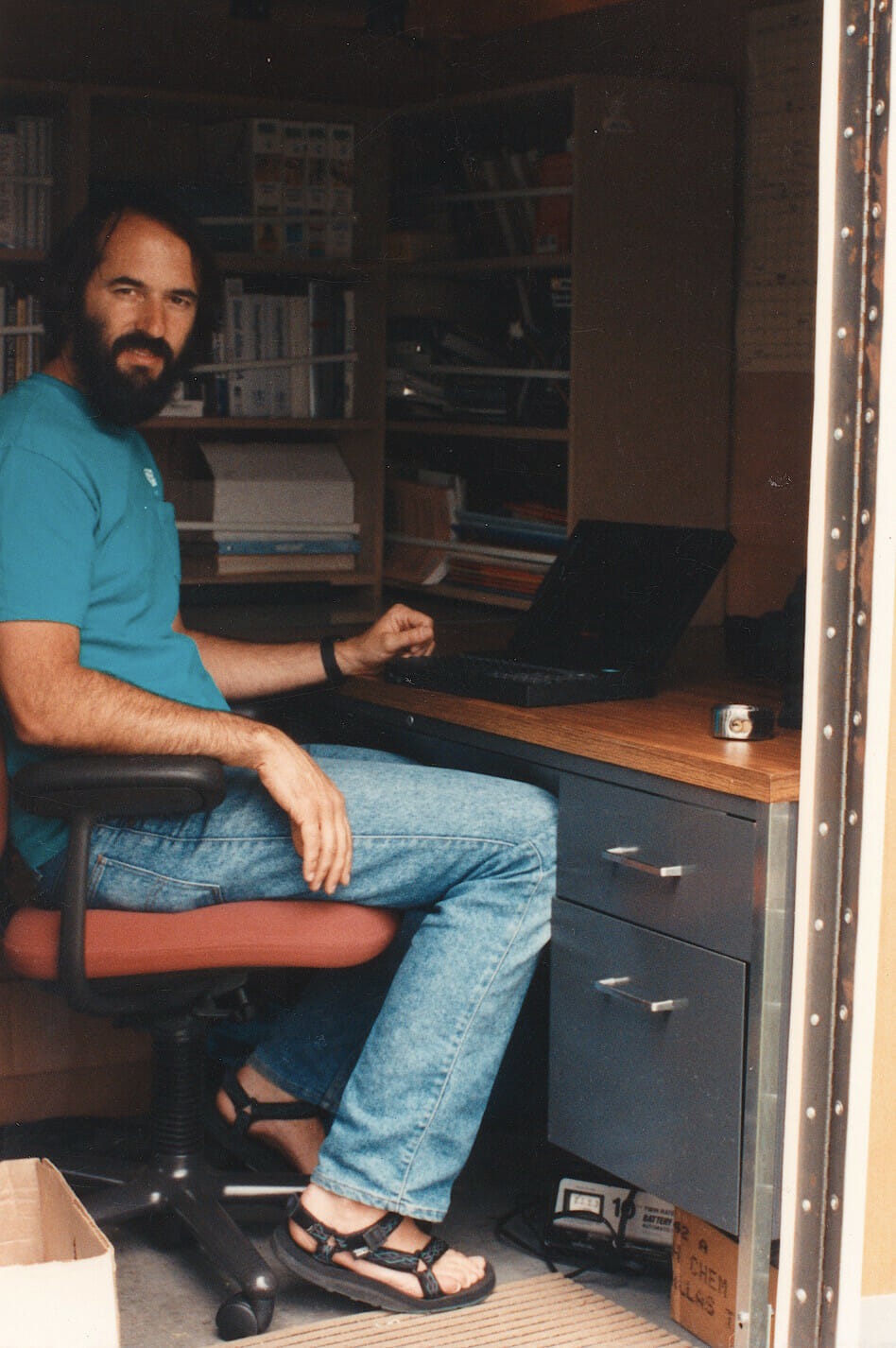
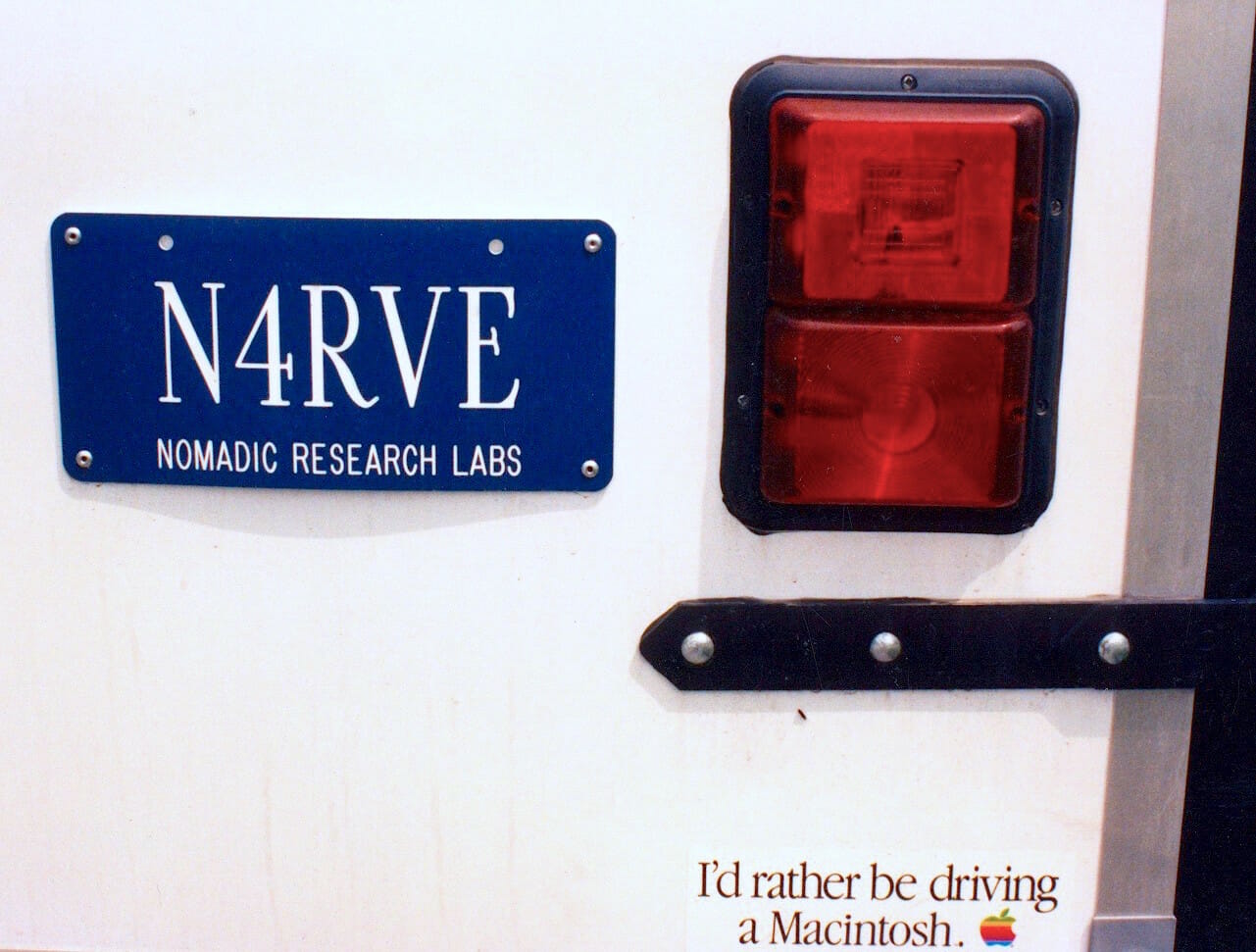
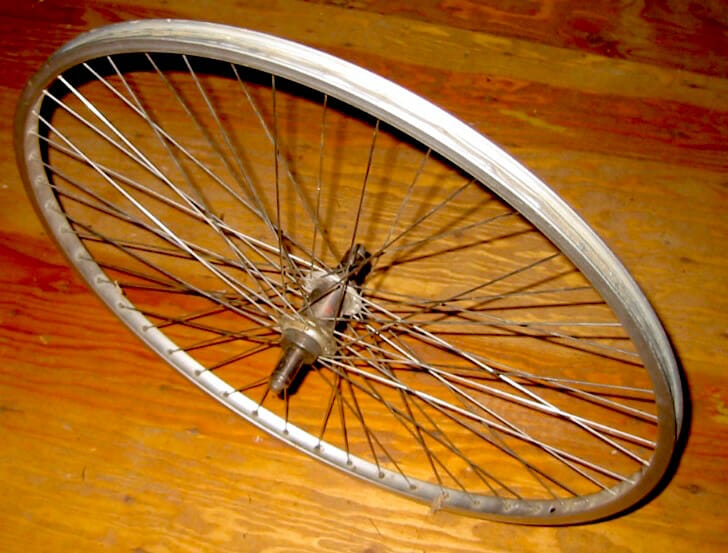

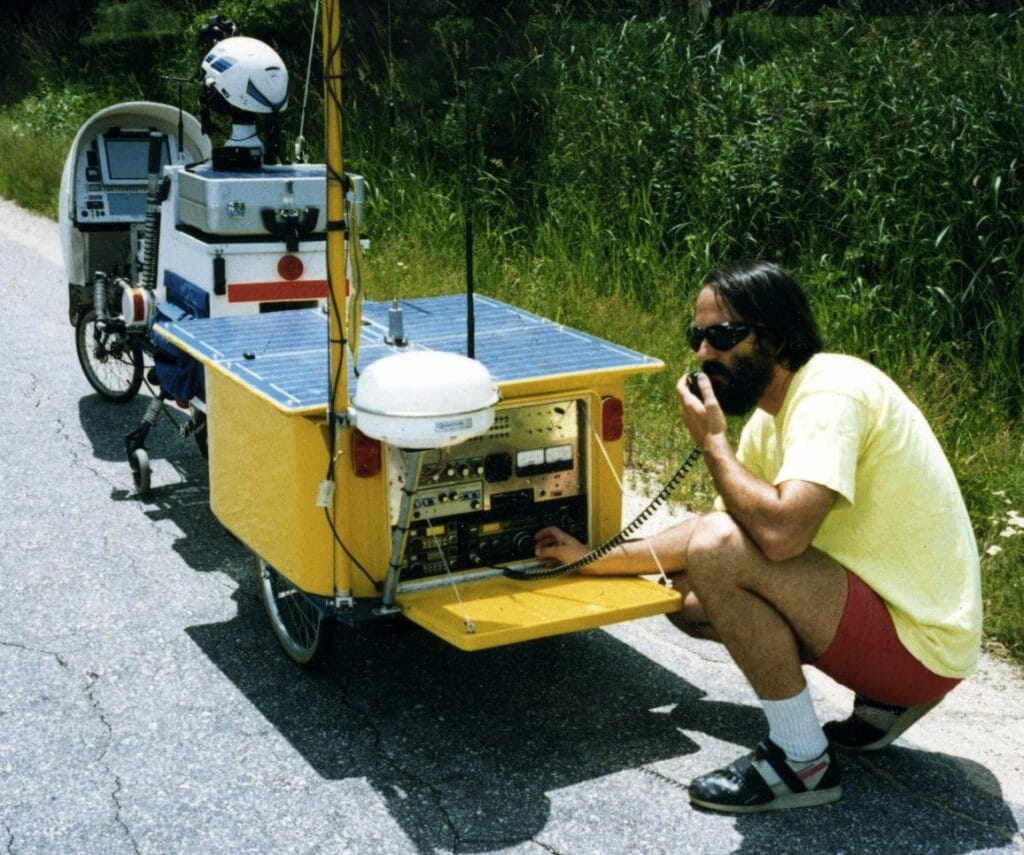
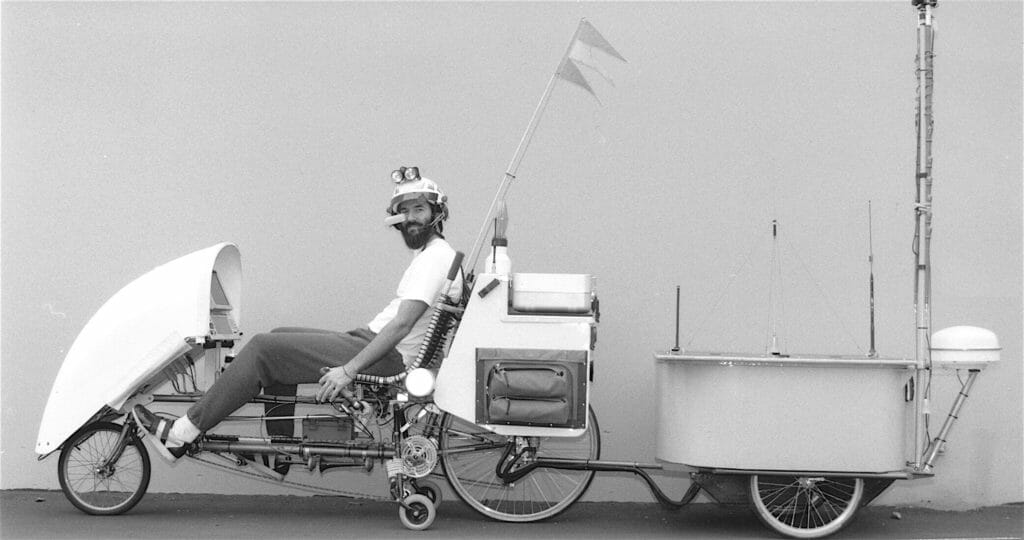

You must be logged in to post a comment.